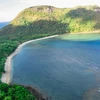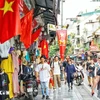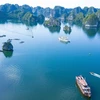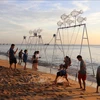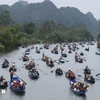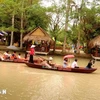The authorities and people of the northern province of Quang Ninh have spared no efforts in protecting Ha Long Bay and its valuable biological and geographical assets since being recognised as a World Heritage site two decades ago.
On December 17, 1994, UNESCO designated the bay a World Heritage site of globally outstanding value in terms of natural landscape. The recognition was extended in 2000, and in 2011 Ha Long Bay outranked 261 other landscapes from all over the world and was voted one of the seven new natural wonders of the world.
The recognition acknowledges the bay’s exceptional rock cave and limestone mountain system which took millions of years to form, as well as its outstanding biodiversity.
Scientists identified more than 500 species of high-level plants in the bay, which spans 1,553km2 and includes 1,969 islands of various sizes. Half of the plants have medicinal properties and could potentially be used as medicine. Experts also observed 66 species of amphibians and reptiles, 77 species of bird and 22 species of mammals.
Over 570 species of seabed creatures, around 180 coral species, over 150 species of fish, nearly 150 species of seaweed and sea grass, and 19 species of aquatic plants were identified in the bay and neighbouring Bai Tu Long Bay and Cat Ba Bay.
The preservation of the rich ecosystem is considered urgent since the rapid socio-economic development of modern life has left behind the first signs of damage.
Therefore, environmentally harmful activities have been prohibited, including the shipping of used coal, cement, woodchips and rocks. In addition, mining, sorting and transporting coal in the core area of the bay is no longer allowed.
Hundreds of households that lived on the bay have been resettled to onshore locations, while age-old fishing villages were rearranged to ensure no ugly scars are left behind.
To ensure the bay’s ecosystem is healthy, coastal water is regularly tested, while rubbish floating on the bay is gathered for onshore treatment.
The application of cutting-edge science and technology, like the global positioning technology GPS, the wimax system, and geographical information systems are widely used. Equipment is used to filter oil discharged by ships operating on the bay with a view to keeping the ecosystem healthy.
In August 2014, the provincial People’s Committee approved plans on Ha Long Bay’s environment with a vision towards 2030.
It laid a special emphasis on the protection of the environment and the application of environmental standards certified by Vietnam and developed countries.
By 2020, Ha Long Bay and Ha Long City aim to take the lead in environmental protection and green growth efforts.
By 2030, they both strive to become an ASEAN-standard green growth centre, with Ha Long Bay becoming a leader in sustainable natural resources and environmental management.
The province has cooperated with local and international nature conservation agencies, research institutes, universities, and scientists to research and enhance the bay’s values in terms of biodiversity, culture, history, geography and geomorphology.
Since becoming the world heritage site, Ha Long Bay has welcomed nearly 25 million visitors, contributing to turning Quang Ninh province into a tourism magnet.
According to Pham Thuy Duong, Head of the Ha Long Bay Management Board, tourism aims to generate resources for conservation.
Nature has bestowed priceless values upon Ha Long Bay, and with appropriate conservation efforts the bay can live up to UNESCO’s recognition, Duong said.-VNA
On December 17, 1994, UNESCO designated the bay a World Heritage site of globally outstanding value in terms of natural landscape. The recognition was extended in 2000, and in 2011 Ha Long Bay outranked 261 other landscapes from all over the world and was voted one of the seven new natural wonders of the world.
The recognition acknowledges the bay’s exceptional rock cave and limestone mountain system which took millions of years to form, as well as its outstanding biodiversity.
Scientists identified more than 500 species of high-level plants in the bay, which spans 1,553km2 and includes 1,969 islands of various sizes. Half of the plants have medicinal properties and could potentially be used as medicine. Experts also observed 66 species of amphibians and reptiles, 77 species of bird and 22 species of mammals.
Over 570 species of seabed creatures, around 180 coral species, over 150 species of fish, nearly 150 species of seaweed and sea grass, and 19 species of aquatic plants were identified in the bay and neighbouring Bai Tu Long Bay and Cat Ba Bay.
The preservation of the rich ecosystem is considered urgent since the rapid socio-economic development of modern life has left behind the first signs of damage.
Therefore, environmentally harmful activities have been prohibited, including the shipping of used coal, cement, woodchips and rocks. In addition, mining, sorting and transporting coal in the core area of the bay is no longer allowed.
Hundreds of households that lived on the bay have been resettled to onshore locations, while age-old fishing villages were rearranged to ensure no ugly scars are left behind.
To ensure the bay’s ecosystem is healthy, coastal water is regularly tested, while rubbish floating on the bay is gathered for onshore treatment.
The application of cutting-edge science and technology, like the global positioning technology GPS, the wimax system, and geographical information systems are widely used. Equipment is used to filter oil discharged by ships operating on the bay with a view to keeping the ecosystem healthy.
In August 2014, the provincial People’s Committee approved plans on Ha Long Bay’s environment with a vision towards 2030.
It laid a special emphasis on the protection of the environment and the application of environmental standards certified by Vietnam and developed countries.
By 2020, Ha Long Bay and Ha Long City aim to take the lead in environmental protection and green growth efforts.
By 2030, they both strive to become an ASEAN-standard green growth centre, with Ha Long Bay becoming a leader in sustainable natural resources and environmental management.
The province has cooperated with local and international nature conservation agencies, research institutes, universities, and scientists to research and enhance the bay’s values in terms of biodiversity, culture, history, geography and geomorphology.
Since becoming the world heritage site, Ha Long Bay has welcomed nearly 25 million visitors, contributing to turning Quang Ninh province into a tourism magnet.
According to Pham Thuy Duong, Head of the Ha Long Bay Management Board, tourism aims to generate resources for conservation.
Nature has bestowed priceless values upon Ha Long Bay, and with appropriate conservation efforts the bay can live up to UNESCO’s recognition, Duong said.-VNA








